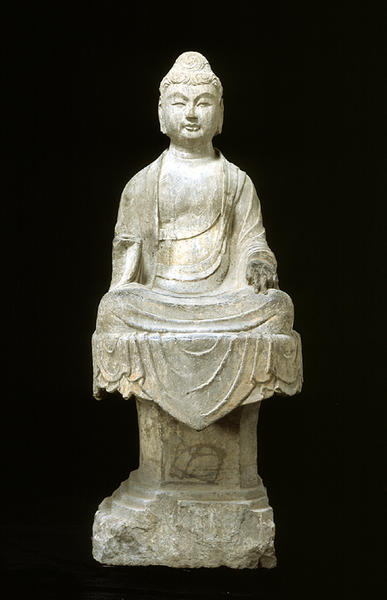如来坐像
- 龍門出土
- 唐時代
- 石灰石
- H-110
- 所蔵
- 龍門石窟研究所蔵
石灰石/龍門出土 唐時代/総高192.8 cm 像高110.0 cm/
龍門石窟研究所蔵
台座とともに1つの石灰石に刻まれている。1987年に出土し、関[かん]林[りん]の洛陽古代芸術館に展示されていた。肉[につ]髻[けい]正面に1つと地髪部の正面に2つの渦巻形をつくり、他を1列ごとに上向きと下向きのU字形を繰り返す髪型、円筒状の首や丸い両肩、膝前で下向きにカーブする線で表された衣文、8角形の台座に懸かる裳の表現は敬善寺洞の如来坐像(46頁、参考図版X)に通じた要素をもちながら、面貌の表現や体躯の肉体表現は敬善寺像と比べればはるかに硬い。敬善寺洞の時期をすこし遡る頃の制作と推定される。
Catalogue Entry
Limestone/ Excavated at Longmen, Tang dynasty/ Overall H. 192.8 cm;
Fig. H. 110.0 cm; Pedestal H. 82.8 cm/ Longmen Caves Research Institute
The figure and pedestal were carved from one block of limestone. This sculpture, excavated in 1987, has long been on display in the Luoyang Ancient Art Museum in Guanlin. The hair on the front of the usnisa is formed in one swirl, the hair on the front of the head is formed in two swirls, while the other hair on the head is shown in rows of curls facing either up or down. The neck is tubular and both shoulders are rounded. The drapery in front of the figure's knees forms three downward curved lines, and the skirt-like section of the robe hangs over the front of the octagonal pedestal. While all of those elements are the same as those seen on the Buddha images in the Jingshansidong Cave (see p. 46, Figure X), the facial expression and depiction of the figure's body is much harder than those seen on the Buddha images in the Jingshansidong Cave. These similarities and differences suggest that this work was created a bit earlier than the Jingshansidong Cave's period of production.
Jingshansidong Cave (see p. 46)
According to the inscription on the outside of the Jingshansidong Cave, the Jingshansidong Cave is surmised to have been built from approximately the Zhenguan period through the Longshuo period (656-664) upon the commission of Empress Wu, the wife of Emperor Taizong (626-649). Stylistic advances in the carvings in this cave can be sensed in the gentler figural expression and the Lokapala wearing Chinese Turkistan style armor.
